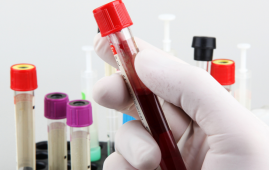

A protein called TDP-43 is lost from its usual place in the cell nucleus in almost all individuals with amyotrophic lateral sclerosis (ALS) and in up to half of all cases of Alzheimer’s disease (AD) and frontotemporal dementia. As a result, stathmin-2 is lost, which is needed for the regeneration of neurons and the preservation of the connections between those neurons and the muscle fibers that are necessary for contraction and movement. A group of researchers led by Don Cleveland, Ph.D., Distinguished Professor of Medicine, Neurosciences, and Cellular and Molecular Medicine at the University of California San Diego School of Medicine, show that stathmin-2 loss can be prevented using designer DNA drugs that restore normal processing of protein-encoding RNA in a paper published in Science on March 16, 2023.
With mouse models, we engineered to misprocess their stathmin-2 encoding RNAs, like in these human diseases, we show that administration of one of these designer DNA drugs into the fluid that surrounds the brain and spinal cord restores normal stathmin-2 levels throughout the nervous system,” Cleveland said.
The idea of designer DNA therapies, which work to either turn on or turn off genes involved with numerous degenerative disorders of the aging human brain system, including ALS, AD, Huntington’s disease, and cancer, is widely credited to Cleveland.
Clinical trials for a number of designer DNA medications are underway for various disorders. Spinal muscular atrophy is a neurological illness that affects children, and one such medication has been licensed to treat it. The new study adds to prior work by Cleveland and others on the function of TDP-43, a protein linked to ALS, AD, and other neurodegenerative diseases, and its loss. The motor neurons that innervate and cause the contraction of skeletal muscles are affected by TDP-43 loss in ALS, leading to their degeneration and eventually paralysis.
“In almost all of the instances of ALS, there is an aggregation of TDP-43, a protein that functions in the maturation of the RNA intermediates that encode many proteins. Reduced TDP-43 activity causes misassembly of the RNA-encoding stathmin-2, a protein required for maintenance of the connection of motor neurons to muscle,” said Cleveland.
“Without stathmin-2, motor neurons disconnect from muscle, driving paralysis that is characteristic of ALS. What we have now found is that we can mimic TDP-43 function with a designer DNA drug, thereby restoring correct stathmin-2 RNA and protein level in the mammalian nervous system.” In particular, the scientists altered mouse genes to include human STMN2 gene sequences before administering cerebral spinal fluid with antisense oligonucleotides, which are tiny fragments of DNA or RNA that can bind to particular RNA molecules and prevent them from producing proteins or alter the way their final RNAs are put together. The injections fixed the misprocessed STMN2 pre-mRNA and entirely restored stathmin-2 protein expression without relying on TDP-43 activity.
“Our findings lay the foundation for a clinical trial to delay paralysis in ALS by maintaining stathmin-2 protein levels in patients using our designer DNA drug,” Cleveland said.
more recommended stories
 Parkinson’s Disease Care Advances with Weekly Injectable
Parkinson’s Disease Care Advances with Weekly InjectableA new weekly injectable formulation of.
 New Blood Cancer Model Unveils Drug Resistance
New Blood Cancer Model Unveils Drug ResistanceNew Lab Model Reveals Gene Mutation.
 Osteoarthritis Genetics Study Uncovers New Treatment Hope
Osteoarthritis Genetics Study Uncovers New Treatment HopeOsteoarthritis- the world’s leading cause of.
 Antibody Breakthrough in Whooping Cough Vaccine
Antibody Breakthrough in Whooping Cough VaccineWhooping cough vaccine development is entering.
 Scientists Unveil Next-Gen Eye-Tracking with Unmatched Precision
Scientists Unveil Next-Gen Eye-Tracking with Unmatched PrecisionEye-tracking technology has long been a.
 Men5CV: Hope for Ending Africa’s Meningitis Epidemics
Men5CV: Hope for Ending Africa’s Meningitis EpidemicsA landmark global health study led.
 Stem Cell Therapy Shows 92% Success in Corneal Repair
Stem Cell Therapy Shows 92% Success in Corneal RepairA groundbreaking stem cell therapy known.
 Gene Therapy for Maple Syrup Urine Disease
Gene Therapy for Maple Syrup Urine DiseaseResearchers at UMass Chan Medical School.
 How Fast Are Your Organs Aging? Simple Blood Test May Tell
How Fast Are Your Organs Aging? Simple Blood Test May TellNew research from University College London.
 HEALEY Platform Accelerates ALS Therapy Research
HEALEY Platform Accelerates ALS Therapy ResearchA New Era of ALS Clinical.

Leave a Comment